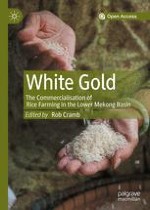Introduction
Type of actor | No. interviewed |
|---|---|
Farmers | 228 |
Vietnamese traders | 1 |
Fertilizer import companies | 2 |
Fertilizer shops | 8 |
Rice millers | 3 |
Thasano Seed Production Centre | 1 |
Rice Production Improvement Project | 1 |
Individual villagers | 1 |
Individual suppliers | 5 |
The Fertilizer Supply Chain
Actors in the Supply Chain
Supplier | Imports (tons/year) |
|---|---|
Vietnamese trader | 40 |
Fertilizer shop | 5800 |
Rice miller | 48 |
Import company | 6175 |
Seed production centre | 37,025 |
Fertilizer Transactions
Supplier | Farmers paying cash (%) | Farmers using credit (%) |
|---|---|---|
Shop/import company | 60.0 | 4.0 |
Individual agent | 5.5 | 17.0 |
Vietnamese trader | 0.0 | 8.5 |
Miller | 0.5 | 2.0 |
Seed centre | 0.0 | 1.25 |
Rice production project | 0.0 | 1.25 |
Type of fertilizer | Cash price (kip/50 kg bag) | Credit price (kip/50 kg bag) | Difference (kip/50 kg bag) |
|---|---|---|---|
Thai brand (Ox Brand, Rabbit Brand) | |||
46-00-00 | 250,000 | 300,000 | 50,000 |
15-15-15 | 300,000 | 375,000 | 75,000 |
Vietnamese brand (Football Brand) | |||
46-00-00 | 150,000–175,000 | 250,000 | 75,000–100,000 |
Supplier and type of fertilizer | Purchase price (LAK/kg) | Selling price (LAK/kg) | Margin (%) |
|---|---|---|---|
Trader | |||
46-00-00 | 4700 | 5900 | 25.5 |
15-15-15 | 4400 | 4900 | 11.4 |
16-20-00 | 4400 | 4900 | 11.4 |
Shop | |||
46-00-00 | 4700 | 4900 | 4.3 |
15-15-15 | 4800 | 4950 | 3.1 |
16-20-00 | 4400 | 4500 | 2.3 |
Import company | |||
46-00-00 | 4100 | 4200 | 2.4 |
15-15-15 | 4300 | 4200 | (2.4) |
16-20-00 | 3600 | 4200 | 16.7 |
Miller | |||
46-00-00 | 4800 | 5700 | 18.8 |
15-15-15 | 5000 | 6000 | 20.0 |
16-20-00 | 4200 | 4700 | 11.9 |
Constraints and Problems
The Seed Supply Chain
Origin and Uptake of Improved Varieties
Actors in the Supply Chain
Source | No. of respondents | % of respondents |
|---|---|---|
Seed production centre | 40 | 17.5 |
Rice Production Improvement Project | 45 | 19.7 |
Farmers’ seed production group | 42 | 18.4 |
Miller | 4 | 1.8 |
Within village | 93 | 40.8 |
Other village | 4 | 1.8 |
Total | 228 | 100.0 |
Seed producer | Production/purchase cost (LAK/kg) | Selling price (LAK/kg) | Margin (%) |
|---|---|---|---|
Thasano Seed Production Centre | 3000 | 5000–6000 | 66–100 |
Napok Seed Production Centre | 3000 | 5000 | 66 |
Farmer group (selling to farmers) | 2000 | 2500–3000 | 25–50 |
Farmer group (selling to government) | 2000 | 2000–2500a | 0–25 |
Millers | 2000 | 2500–3000 | 25–50 |
